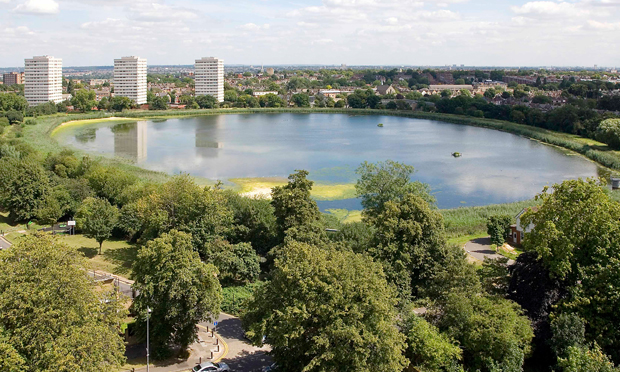Campaigners hail council’s ‘ambitious and urgent’ new greenprint for Hackney

Stoke Newington East Reservoir, site of Woodbury Wetlands. Photograph: London Wildlife Trust
A greenprint to make Hackney more welcoming to wildlife and more resilient to some of the worst impacts of the climate emergency has been hailed as “big on ambition” by campaigners.
Hackney’s cabinet adopted a local nature recovery plan and green infrastructure strategy as its latest steps to help combat the impact of climate change.
It pinpoints seven areas in south-west Hackney in greatest need of green space – Shoreditch, Haggerston, Hoxton, Dalston, Hackney Central, London Fields and De Beauvoir.
The council aims to creating seven green links between open spaces to open up the concrete jungle, use plants to create barriers to air pollution and noise pollution on council estates, as well as more gardens for residents to grow fruit and vegetables, and rain gardens to store and release rain from heavy downpours.
The council also wants to create more wildlife gardens to boost biodiversity in Hackney.
Other moves include planting more trees and pocket parks on streets, including its network of controversial low traffic neighbourhoods and encouraging developers to make new developments and regeneration sites greener.
It will also see more street trees planted in priority areas including Northwold Road, Rectory Road, Lea Bridge Road in the north of Hackney and Hoxton Street and Curtain Road in Shoreditch.
The borough has green cover in 40 per cent of its land, including parks and open spaces and Cllr Caroline Woodley, who is the cabinet member for parks, said there are “potential dangers to residents if we fail to address the need for increased canopy cover, greater surface drainage and more resilient planting to withstand the threats of air pollution, urban heat islands, flood and fire.”
Hackney is amongst the six London boroughs thought to be most at risk of problems caused extreme heat and flooding created by the climate emergency. It is also one of the most densely occupied parts of London.
The borough will be divided into five nature recovery areas to try and reverse the decline in numbers of wildlife.
These areas are Woodberry Down and Stoke Newington, Springfield and Stamford Hill, Lea Bridge and Hackney Downs, Hackney Wick and London Fields, and the Regent’s Canal and Hackney South.
The council aims to build on the work protecting habitats in areas including Woodberry Wetlands and Abney Park Cemetery and on the work community groups have been doing in the borough for decades.
Cllr Woodley paid tribute to residents and community groups including the Tree Musketeers and Growing Kitchen who shared their ideas in a consultation last year.
She said: “They really care about the natural world in a densely-packed area like Hackney.”
And she said residents enjoy the new managed meadows at Hackney Downs, London Fields and Millfields Park, especially when they understand they have been created to support more wildlife.
Sustainable Hackney Biodiversity and Green Spaces lead, Gerry Tissier, said the seven-year strategies are “big on ambition and urgency” to combat climate and biodiversity emergencies and help protect residents’ health.
He said Sustainable Hackney backed a “vision of a borough-wide web of ‘liveable neighbourhoods’ where nature and people thrive together.”
“Sustainable Hackney welcomes the commitments to improve parks for wildlife, establish new sites of importance for nature conservation, and create greener streets and housing estates. We applaud the new policy to avoid herbicide use across the borough.”
He called for a green fund for Hackney’s community greening and gardening groups and for a biodiversity officer “without delay” to create plans for declining and threatened species and to help at-risk wildlife to recover.
Mr Tissier also warned that “intense development pressures threaten important wildlife habitats” and urged the council to ensure new developments create a biodiversity net gain “in their vicinity” rather than offsetting it elsewhere.
The council intends to fund a biodiversity planning officer to keep an eye on plans.
